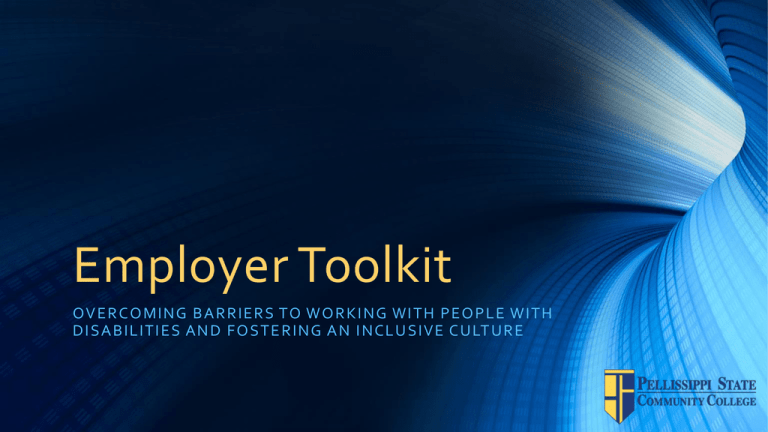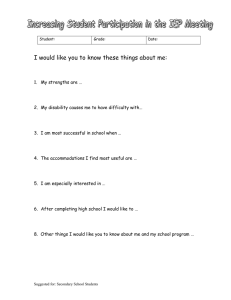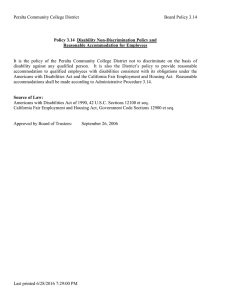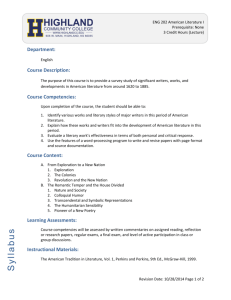Employer Toolkit
advertisement

Employer Toolkit OVE R CO MING B A R R I E R S TO WO R K I NG WI T H P E O P L E WI T H DISA B I LITI ES A ND FOST ER ING AN INCLUSIVE CULT URE America Works Best When Everybody Works Inclusion builds a better workforce. A recent study by Adecco USA found that, not only did the majority of workers think that a diverse workforce makes their organization more successful, the majority also felt that the more diverse their company, the more productive a worker they would become. For a Four-Step Reference Guide to Building an Inclusive Workforce click here Diversify Your Workforce According to a case study in Do Ask, Do Tell, Wells Fargo put in place practices to create a more disability-inclusive workplace by implementing the following: • Articulate a clear business case for why employing individuals with disabilities is important • Put a face on disability by sharing the stories of employees with disabilities • Foster a strong resource group/business network on disabilities • Capitalize on the convergence of aging workforce issues and disability issues • Help managers and employees be “disability confident” • Communicate the benefits of self-identification for the employee Good Workplace Policies and Practices for People with Disabilities Benefit Everyone • The stimulus that drives innovation and growth is talent; organizations that identify and recognize talent are best positioned to succeed in both good times and bad. • Employees with disabilities: Have Talent Help businesses gain a competitive edge through innovative thinking Mirror an important and increasingly expanding customer base Are experienced problem solvers with a proven ability to adapt Value and want to work For more information go to What Can You Do? (What Can You Do?, n.d.) Americans with Disabilities Act (ADA) Basics The ADA is a federal civil rights law that was passed in 1990. Its purpose is to protect people with disabilities from discrimination in employment. It also, requires employers to provide reasonable accommodations for employees with disabilities. (Job Accommodation Network, 2015) ADA Basics continued The term disability as it applies to the ADA means: (1) a person who has a physical or mental impairment that substantially limits one or more major life activity, (2) a person with a record of such impairment, or (3) a person who is regarded as having such impairment. (JAN, 2015) What is a Reasonable Accommodation? A reasonable accommodation is a modification or adjustment to a job, the work environment, or the way things usually are done that enables a qualified individual with a disability to enjoy an equal employment opportunity. The ADA requires reasonable accommodations in three aspects of employment: 1) To ensure equal opportunity in the application process 2) To enable a qualified individual with a disability to perform the essential functions of a job 3) To enable an employee with a disability to enjoy equal benefits and privileges of employment (JAN, 2015) Appropriate Etiquette for Interviewing People with Disabilities Interview Etiquette • When referring to anyone with a disability refer to the individual first, then to his or her disability. It is better to say “ a person with a disability” than “the disabled.” • Schedule interviews at an accessible location. If the workplace is inaccessible, be prepared to conduct the interview at an alternate accessible location. Provide directions to an accessible path into the building. (Job Accommodation Network, 2011) Interview Accommodations • Let applicants know accommodations can be provided upon request and who to contact for more information. • Employers have an obligation to make reasonable accommodations to enable applicants with disabilities to participate in the interview process. • Accommodations for interviews may include: an accessible interview location for people with mobility impairments, a sign language interpreter for a person who is deaf, a reader for a person who is blind, and modified testing for a person with a learning disability. Disability Etiquette Greeting the Interviewee • Be aware of the interview location’s accessible features including restrooms, drinking fountains, and telephones. • Use a normal tone of voice when welcoming the interviewee. • Call the person by their first name only when extending similar familiarity to other interviewees. • Speak directly to the interviewee instead of any companion, personal attendant, or interpreter. (JAN, 2011) Disability Etiquette Interviewing • Always ask similar questions of all interviewees, regardless of disability. Conduct the interview emphasizing abilities, achievements, and interviewee qualities. • Treat all interviewees with respect. • Select an interview location with adequate lighting. • Speak directly to the interviewee instead of any companion, personal attendant, or interpreter throughout the meeting. (JAN, 2011) • Review physical features of the work environment. If any create potential barriers for new employees with disabilities, make adjustments as necessary. • Identify assistive technologies that may be necessary to remove barriers for a new employee. Disability Etiquette 2 New Employee • As needed, provide alternate formats (e.g., large print, Braille, accessible documents) of all necessary work related documents. • Prepare co-workers and supervisors with an overall disability awareness initiative that includes training and orientation to disabilityspecific issues. The training should not be used to single out a person with a disability. • Include employees with disabilities in emergency evacuation planning and procedures. (JAN, 2011) Workplace Etiquette 3 Individuals with Mobility Impairments • Do not make assumptions about limitations based on appearance or the use of assistive devices. For example, individuals who use mobility aids such as canes, walkers, or wheelchairs have different limitations and may use a mobility aid regularly or only as required by their limitations on a daily basis. Also, people who appear to be mobile may require accommodations such as accessible parking because they are unable to walk long distances due to a medical impairment (e.g., a person with asthma or a heart condition). • A wheelchair, mobility aid, or service animal is part of an individual’s personal space; an extension of that individual. Do not touch or lean on a wheel chair, move a person’s walker or cane without being asked, or pet or distract a service animal without first asking the individual with the disability if it is okay. (JAN, 2011) Workplace Etiquette 3.5 Individuals with Mobility Impairments • Be aware of the worksite and its accessible and inaccessible elements. Upon hiring a person who has an obvious mobility impairment, offer to provide a tour and evaluate the worksite for accessibility. • Make workplace accessibility changes according to the specific work-related needs of the employee (e.g., making workspace modifications, keeping paths clear, and positioning items at appropriate reach heights, etc.) (JAN, 2011) • Keep disability etiquette in mind when planning workrelated social events or training opportunities. Host events at accessible locations and design activities that include all employees. • Ask whether a person needs assistance before you help. Extend the same courtesies to individuals with disabilities as you would others. Do not be afraid to ask how you can help. Workplace Etiquette 4 Individuals with Mobility Impairments • Sit down when speaking for more than a few minutes with a person who uses a wheelchair so you are at eye level. • Be careful about the language you use. For example, people who use wheelchairs or scooters are not confined or bound to them. The wheelchair enables the person to get where he/she needs to go. It does not confine the person. (JAN, 2011) • Be familiar with the route of travel to the interview location. Provide descriptive directions that do not require the person to rely on visual references. When appropriate, note if Braille signage is posted on walls and doors. Workplace Etiquette 5 Individuals with Vision Impairments • Verbally greet and identify yourself before extending your hand to greet a person who is blind. Use the same courtesy when entering or leaving a room, or saying good bye when ending a conversation. Do not just walk away when talking with a person who is blind or visually impaired. • Offer your arm instead of taking the arm of a person who is blind or visually impaired when guiding the person. As you walk, tell the person where you are going, make note of steps or slopes, and point-out opening doors or other obstacles. • Offer new employees a guided tour of the workplace. (JAN, 2011) • Do not pet or distract a guide dog. When walking along-side someone who is using a guide dog, walk on the side opposite the animal. • Offer to read written information, when appropriate, during an interview or on the job. Workplace Etiquette 6 Individuals with Vision Impairments • Inform an employee who is blind or visually impaired of structural changes or hazards he may need to be aware of in the event of new construction or workplace modifications. • Provide work-related materials, such as employee handbooks or benefits information, in an accessible format (e.g., large print, Braille, or accessible web page accessed with a screen reader). (JAN, 2011) • Be aware that individuals who are deaf or hard of hearing communicate in various ways. Pay attention to cues such as whether the person uses sign language, is reading lips, writing, or gesturing. Do not be afraid say that you do not understand if you have trouble understanding the person’s speech. It is better to find another way to communicate, such as through writing notes, than to pretend to understand. Workplace Etiquette 7 Individuals Who are Deaf or Hard of Hearing • Do not put hands in front of your face, or food or other items in your mouth when communicating with someone who is reading lips. Also, do not turn your head or walk away while talking. When possible, speak in a well-lit room that is free from background noises. • Maintain eye contact and direct your communication to the person who is deaf when using a sign-language interpreter. • Speak using a normal tone of voice unless asked to raise your voice, and rephrase rather than repeat the same words if you are not understood. (JAN, 2011) • Take turns when talking during a meeting so the person who is deaf or hard of hearing can read lips if they are able to. • Get the attention of a person who is deaf or hard of hearing before you start speaking by waiving your hand, tapping her on the shoulder, or through some other appropriate gesture. Workplace Etiquette 8 Individuals Who are Deaf or Hard of Hearing • Talk with the individual about his preferred method of communication for job training or complex workrelated situations. When appropriate, provide a qualified sign-language interpreter, CART service, or training videos that are captioned. • Remember to include employees who are deaf or hard of hearing in casual conversation and social events. Provide a sign-language interpreter for employer-sponsored social events, when appropriate. (JAN, 2011) • Be patient and listen. Do not complete words or sentences for the individual. Do not be afraid to say you do not understand. Ask him to repeat and then listen carefully. Repeat what you heard to verify. Or, ask him to write it down. Workplace Etiquette 9 Individuals with Speech Impairments • Be attentive in your mannerisms by maintaining conversational eye contact and focusing on the content of communication rather than the delivery of the communication. • Relax and communicate as you would normally. • Provide interview questions in advance, if possible, to allow the individual time to prepare and deliver responses effectively. • Consider offering a personal interview as an alternative to a phone interview for people who stutter. (JAN, 2011) • Be aware that products that are commonly used in the workplace (e.g., air fresheners, cleaning products, markers) can trigger a reaction for someone who has a respiratory or chemical sensitivity. Use less toxic products when possible. Workplace Etiquette 10 Individuals with Respiratory Impairments or Chemical Sensitivities • Encourage employees to use fragrance-free products, and discontinue wearing fragrances and colognes in the workplace. Do not wear fragrances and colognes when interviewing new employees. Fragrances, colognes, and fragranced personal products can make some people very ill. • Make a commitment to maintaining good ventilation and indoor air quality. This can benefit all employees. • Do not make assumptions based upon appearance. For example, a person with asthma may not appear to be limited, but may need accessible parking because she is not able to walk long distances or be in the cold or humidity for long periods of time. (JAN, 2011) • Avoid stereotypes and assumptions about the individual and how she may interact with others. In most cases, it will not be obvious that someone has a psychiatric impairment. Workplace Etiquette 11 Individuals with Psychiatric Impairments • Recognize and respect the differences in people. People with psychiatric impairments may behave differently than other individuals, may have trouble interpreting social cues, or may have different ways of coping with their impairment. • Respect personal space and do not touch the individual or his personal belongings. • Provide support and assistance, as appropriate. • Be patient. Allow the individual time to think and answer questions independently. (JAN, 2011) • Do not assume that because someone has a cognitive impairment, such as a learning disability, that she has below-average intelligence. The individual may have above-average intelligence, but may have difficulty receiving, expressing, or processing information. Workplace Etiquette 12 Individuals with Cognitive Impairments • Ask the person if he prefers verbal, written, or hands-on instruction, or a combination of methods in training and work-related situations. For example, if providing verbal instructions, it may be helpful to follow-up with an e-mail that clarifies your request. • Treat the individual as an adult. Speak directly to the individual, rather than his/her companion, and use words and phrases according to his or her level of complexity. • Be patient. Allow the individual time to think and answer questions independently. (JAN, 2011) Communicating With and About People with Disabilities in the Workplace It is human nature and not unusual, therefore, to be concerned about interactions with people who use wheelchairs, who are blind, who are deaf, or whom we find difficult to understand. We may be concerned that we will say the wrong thing, ask an inappropriate question, or unintentionally offend. We do not want to appear uninformed or insensitive. A key to any effective communication is to focus on the communication itself — what information needs to be transmitted and how best to transmit it. Positive language empowers. When writing or speaking about people with disabilities, it is important to put the person first — to focus on the person, not the disability. Group designations, such as "the blind," "the deaf" or "the disabled" are not empowering. It is important to use words that reflect individuality, equality or dignity — the person who is blind, the individual with a disability, for example. (Department of Labor, n.d.) Positive and Negative Phrases to Describe People with Disabilities Positive Phrases Not Negative Phrases Person with an intellectual, developmental disability not the retarded Person who is blind or visually impaired not the blind Person with a disability not the disabled; handicapped The deaf or a person who is hard of hearing not deaf and dumb Person with multiple sclerosis not someone afflicted by MS Person with cerebral palsy not a CP victim Person with epilepsy or a seizure disorder not an epileptic; person with fits (JAN, 2011) Positive and Negative Phrases to Describe People with Disabilities continued Positive Phrases Not Negative Phrases Person who has muscular dystrophy not someone stricken by MD Person who uses a wheelchair; wheelchair user not person confined, bound or restricted to a wheelchair A person with a psychiatric disability not a crazy person Person who is unable to speak, person who uses synthetic speech not a mute Person with a physical disability, person who is physically disabled not a person who is crippled, lame or deformed Person who is successful, productive not a person who has overcome his/her disability; person who is courageous (JAN, 2011) Accommodations All employees need the right tools and work environment to effectively perform their jobs. Similarly, individuals with disabilities may need workplace adjustments — or accommodations — to maximize their productivity. (U.S. Department of Labor, n.d.b.) Aren’t Accommodations Expensive? Most accommodations are low cost yet yield considerable direct and indirect benefits. In fact, data collected by the Job Accommodation Network (JAN) over the years reveal that more than half of accommodations cost employers nothing, and of those that do cost, the typical one-time expenditure is $500 — an outlay that most employers report pays for itself multiple-fold in the form of reduced insurance and training costs and increased productivity. (DOL, n.d.b.) Job Accommodation Network (JAN) The Job Accommodation Network (JAN) is a free and confidential consulting service for employers that expands employment opportunities for individuals with disabilities by providing: • Individualized worksite accommodation solutions • Technical assistance with the Americans with Disabilities Act (ADA) and other disability-related legislation (Department of Labor, n.d.a.) Job Accommodation Network (JAN) Continued • Providing employers with customized worksite accommodation solutions is at the core of JAN's mission. An accommodation is a modification to the work environment that enables a qualified individual with a disability to participate in the job application process, or perform the essential functions of a job, or equally benefit from the same employment opportunities and rights afforded similarly situated individuals without disabilities. • By providing guidance on practical accommodation options, JAN helps employers hire, retain and advance qualified individuals with disabilities. It can also help them reduce workers' compensation and other insurance costs and understand their legislative responsibilities. • (DOL, n.d.a) Job Accommodation Network (JAN) Telephone Assistance 800 526-7234 (Voice), 877 781-9403 (TTY) • JAN provides these services over the telephone in both English and Spanish, Monday through Friday from 9:00 a.m. to 6:00 p.m., Eastern Standard Time (EST). When an individual calls JAN, an information assistant will first ask him or her to answer a few basic questions about the nature of the person's disability and job. This information helps determine which JAN consultant will handle the situation. JAN's consultants work in teams specializing in particular types of disabilities and accommodations. Each consultant has at least one advanced degree in a relevant field, such as vocational rehabilitation, psychology, special education, ergonomics, safety management or law. • The appropriate consultant will ask the caller for further information regarding the person's essential job functions and his or her functional limitations. JAN recommends accommodation solutions tailored to the person's needs and essential job functions. Consultants also can advise on implementation, such as how and where to obtain any necessary equipment, whether it be simple hardware or advanced technology that is needed. They may also provide follow-up printed materials via e-mail, fax and/or regular mail. • In addition to tailored worksite accommodations, JAN counsels on related issues such as interviewing and testing, policy modification, professional education and job-related travel. (DOL, n.d.a) Job Accommodation Network (JAN) Electronic Assistance JAN also provides accommodation assistance through the JAN Web site. Information is categorized by both topic and audience, and an Accommodation Toolbox (askjan.org) centralizes all of JAN's accommodation resources, including downloadable fact sheets and other publications with accommodation ideas and expertise. A feature called JAN by Disability A-Z offers quick and easy access to all of JAN's information on a particular disability. JAN's Web site resources and phone consultation services help advance opportunities for not only qualified individuals with disabilities, but also the employers who benefit from their talents. As a result, JAN plays an important and unique role in contributing to the strength of the nation's workforce, economy and communities. (DOL, n.d.a) Job Accommodation Network (JAN) SOAR JAN's Searchable Online Accommodation Resource (SOAR) is an interactive Web tool that delivers customized job accommodation information by simulating the interaction users would have if they were speaking with a JAN consultant. The user is first asked to identify a particular impairment, limitation and job function from pre-set lists. Then, based on the user's responses, the system generates a list of potential accommodations, each one linked to a page with further information and resources, if appropriate. I f an accommodation requires special equipment or technology, SOAR also provides guidance on how such products can be obtained. A widget to connect to SOAR can be found on the UPEP page at Link to SOAR widget (DOL, n.d.a) Additional Resources • Small Business Disability Inclusion Fact Sheet click here • Inclusive Internship Programs click here • Business Strategies that Work: A Framework for Disability Inclusion click here • Employer Assistance and Resource Network (EARN) – ODEP funded service that helps employers hire and retain workers with disabilities Click here • Workforce Recruitment Program – A recruitment and referral program that connects federal ad private sector employers nationwide with highly motivated college students and recent graduates with disabilities who are eager to prover their abilities in the workplace through summer and permanent jobs. Click here References Job Accommodation Network (JAN). (2015) Americans with Disabilities Act Basics. Retrieved from http://askjan.org/Erguide/One.htm Job Accommodation Network (JAN). (2011). Effective Accommodation Practices (EAP) Series. Retrieved from https://askjan.org/topics/disetiq.htm United States Department of Labor, Office of Disability Employment Policy. (n.d.b.) Accommodations. Retrieved from http://www.dol.gov/odep/topics/Accommodations.htm United States Department of Labor, Office of Disability Employment Policy. (n.d.a) Customized Solutions for Today’s Workforce: The Job Accommodation Network. Retrieved from http://www.dol.gov/odep/pubs/fact/jan.htm United States Department of Labor, Office of Disability Employment Policy. (n.d.) Effective Interaction: Communicating With and About People with Disabilities in the Workplace. Retrieved from http://www.dol.gov/odep/pubs/fact/effectiveinteraction.htm United States Department of Labor, Office of Disability Employment Policy. (n.d.) What Can You Do Campaign. Retrieved from http://www.whatcanyoudocampaign.org/blog/index.php/what-can-you-do-toolkit/



